Prototyping
?What is Prototyping
Prototyping is a process used in various fields like product design, software development, and engineering to create a preliminary version or model of a product, system, or concept. This prototype is a tangible representation that allows designers, developers, and stakeholders to visualize, test, and refine their ideas before committing to full-scale production or development.
Prototypes can take different forms, depending on the context. They can be physical models, such as 3D-printed objects or mock-ups, or digital versions like interactive software mockups. The key purpose of prototyping is to validate and improve the design, functionality, and user experience of a product or system, ultimately leading to a more successful and user-friendly final product.
Ideation and Conceptualization
The “Ideation and Conceptualization” stage is the initial phase of the prototyping process where innovative ideas and concepts are generated, explored, and refined. During this stage, individuals or teams brainstorm and sketch out various concepts for a product, system, or solution. The goal is to nurture creativity, envision possibilities, and define a clear direction for the project. It often involves conducting market research, identifying user needs, and considering various design options. The output of this stage is a well-defined concept or idea that serves as the foundation for the subsequent stages of prototype development and testing. Ultimately, the Ideation and Conceptualization stage is crucial for establishing a solid vision and roadmap for the project.
Prototypes can take different forms, depending on the context. They can be physical models, such as 3D-printed objects or mock-ups, or digital versions like interactive software mockups. The key purpose of prototyping is to validate and improve the design, functionality, and user experience of a product or system, ultimately leading to a more successful and user-friendly final product.

Development and Testing
where the conceptualized idea is transformed into a tangible prototype. During this phase, designers and engineers focus on creating digital or physical representations of the product, which closely resemble the envisioned final product. This process involves detailed design work, coding (in the case of software), and building physical models. Once the prototype is ready, rigorous testing ensues, often involving usability testing, functional testing, and performance evaluations. The goal is to assess how well the prototype aligns with the project’s objectives, identify any issues or flaws, and gather valuable user feedback to inform further refinements. Ultimately, this stage aims to produce a prototype that not only meets the desired functionality but also provides an accurate representation of the final product.

Iteration and Finalization
where the focus shifts toward refining the prototype based on feedback and further testing. During this crucial phase, any identified issues or improvements are addressed through iterative cycles. Designers and developers work closely to enhance the prototype’s functionality, usability, and aesthetics, making it as close to the desired final product as possible. This stage may involve multiple rounds of adjustments and testing to ensure that the prototype aligns perfectly with the project’s goals and user expectations. Once the necessary refinements are made, and the prototype meets the desired standards, it is ready for finalization, preparing it for the next steps in the development or production process.
Prototypes can take different forms, depending on the context. They can be physical models, such as 3D-printed objects or mock-ups, or digital versions like interactive software mockups. The key purpose of prototyping is to validate and improve the design, functionality, and user experience of a product or system, ultimately leading to a more successful and user-friendly final product.

Have any questions? Interested in our design services? Contact us to get started!










